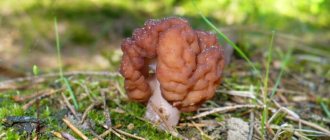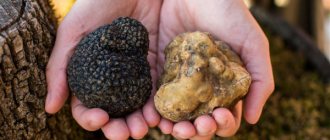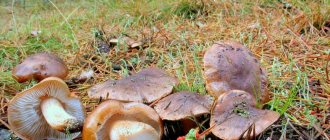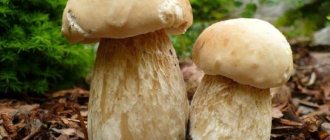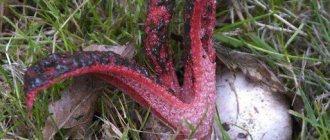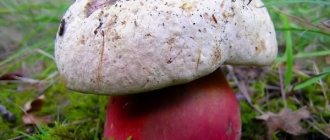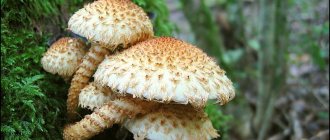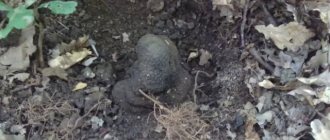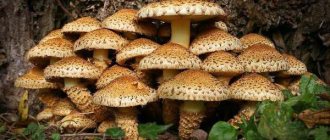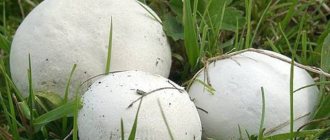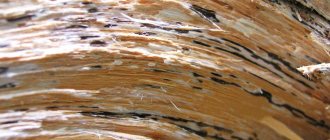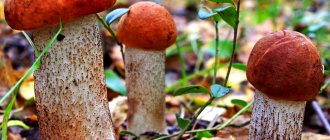One of the most striking representatives of the kingdom of mushrooms is the networt, or double dictyophora. If you are lucky enough to come across this rare specimen while walking through the forest, it is simply impossible not to notice it. First of all, the specific appearance of the fruiting body, which is not typical for other representatives of the kingdom, catches the eye.
The networt is an endangered species and is listed in the Red Book. It grows in temperate climates and is considered a conditionally edible species due to its specific smell. People call her the lady with the veil, which is due to the presence of an openwork net under the hat. It is impossible not to mention the fact that the net moth lives only for a day, and every minute it grows by 5 mm. The attention of many mushroom pickers is attracted by the large number of beneficial properties that this species has.
Brief description of a conditionally edible mushroom
Double networt (or double Dictyophora) is a mushroom of the genus Veselka, class Veselkovye, family Agaricomycetes. The Latin name of the phallomycete species is Phallus duplicatus, Dictyophora duplicata. In its adult state, the double net moth emits a sharp, unpleasant odor to humans, so only young specimens are recommended for consumption.
The mushroom looks like an ovoid fruit body (4–5 cm in diameter) with a smooth surface. The shade of the double net-carrier varies from white and yellow to brown. The mushroom creates a cap after the shell covering the fruiting egg breaks. The leg of the veselka is white, spongy and hollow inside, reaching a length of 20 cm. The cap section, up to 3–5 cm in size, has the shape of a cone and acquires an olive tint with age.
From under the cap, almost to the base of the stem, a white patterned mesh formation of a conical shape peeks out. This is a “veil”, later it acquires a light brown tint with pink or greenish splashes, and at night it glows emerald.
The double net mower is listed in the Red Book of Russia, Moscow region. The reasons contributing to the decline in the number of the fungus are still not well understood. Perhaps the extinction of the species is due to changes in temperature.
Video
A little history
For the first time, the word Phallus was used by a doctor from the Netherlands, Adrian de Jonge, in 1562. And in 1792, the Italian botanist Pier Micheli published an article in which he described the genus Phallus and its 2 species of mushrooms.
In 1801, the Dutch scientist Person added the number of species, talking about them in his work. Gradually, the genus of merry-gooses was replenished - in 1811, a double net-carrier was added.
Use
Young egg-shaped fruiting bodies of the networt are usually eaten raw, after removing the shell and seasoning with salt and spices. You can use the product with sour cream. Dictyophora double is not salted or pickled.
The fruiting bodies of the networt can be fried without removing the shell. But it is believed that after heat treatment their beneficial properties disappear.
Some gardeners are trying to grow networt in their garden plots as an exotic plant. To do this, it is recommended to do this:
- To obtain spores, remove the cap from a double net-carrier and wrap it in mulch from the forest floor.
- In garden conditions, place the cap with a layer of forest substrate under garden organic soil and water it periodically.
- The place where the cap is located must not be dug up or loosened.
Attention! Under favorable conditions, after 2 - 3 years, mycelium will sprout from the spores, and then the first fruiting bodies of the networt.
Time and place of fruiting
The double networt appears in deciduous forests on decomposed wood or soil covered with humus. It grows both in groups and singly. Fruiting time occurs from July to September, but not regularly.
Location in Russia:
- Moscow region;
- Kaluga region;
- Kirov region;
- Belgorod region;
- Republic of Adygea;
- North Ossetia Alania;
- Novosibirsk region;
- Tomsk region;
- Krasnoyarsk region;
- Irkutsk region;
- The Republic of Khakassia;
- The Republic of Buryatia;
- Khabarovsk region;
- Central Black Earth Region;
- Primorsky Krai.
REFERENCE! In addition to the Russian Federation, the mushroom can be found in Africa, Europe, Asia and North America.
Pine cone mushroom
Among the mushrooms with interesting shapes, it is worth highlighting the cone mushroom - a very funny mushroom with a cap that looks like a pine cone. It is convex and completely covered with scales, which hang from the edges of the cap, and are also present on the stem. The color is no less interesting: young cone mushrooms are gray-brown, but as they mature, they become chocolate-black. The pulp of this miracle mushroom, oddly enough, is light, but when cut, it first turns red, and then also becomes dark, almost black with a purple tint. Emits a characteristic mushroom smell.
The cone mushroom is classified as a conditionally edible mushroom: you cannot be poisoned by it, but not everyone likes the fibrous pulp.
Information about false poisonous and edible look-alikes
The mushroom is similar to the following counterparts:
| Species name | Description |
| Dictyophora campanulata | It is larger in size and grows only in South America. Like the double net-carrier, it has a “veil”. The mushroom only lives for a day. |
| Veselka vulgaris | After maturation, the fruit egg is dirty white in color and grows up to 15 cm; has a greenish cap with a cellular structure. The mushroom smells unpleasantly like carrion. |
| Veselka Hadriana | Before ripening, this species has an oblong shape with a diameter of 4–6 cm and is colored pink-purple. Sometimes it comes out of the ground halfway. After the shell ruptures, a porous stalk grows with a wrinkled, slimy dark cap shaped like a bell. The smell of the mushroom is disgusting and attracts many insects. |
Important! Look at photographs of fruiting bodies and compare their appearance.
Similar species
With the exception of the presence of a mesh, the mushroom is similar to all other mushrooms (ordinary, Hadriana, Ravenelli). They all have the same edibility.
Veselki: 1-Ordinary, 2-Hadriana, 3-Ravenelli.
Dictyophora campanulata , a larger South American species, has a structure similar to the oars
Interesting Facts
- Net netting often attracts flies and other insects due to its scent.
- The number of mushrooms reaches 500 specimens.
- Throughout Russia, the double netted moth is found in groups of up to 6 individuals or singly.
Despite its conditional edibility and benefits in the treatment of diseases, if a mushroom is found, it should be left in place, and it is best to inform environmental services about such a wonderful and rare find.
Information sources
Gorlenko M.V. et al. Double dictyophora - Dictyophora duplicata (Bosc.) Fischer // Mushrooms of the USSR / Rep. ed. M. V. Gorlenko. - M.: Mysl, 1980 Rebriev Yu. A. Double netting - Dictyophora duplicata (Bosc) E.Fisch. // Red Book of the Russian Federation (plants and mushrooms) / Comp. R.V. Kamelin and others - M.: Scientific T. KMK publications, 2008
Application
The networt was often compared to a flowering fern, but it was sought for medicinal purposes. This species is widely known due to its beneficial properties, which have been actively used in folk medicine.
Medicinal properties and restrictions on use
The main indications for treatment are:
- gastritis and stomach ulcers;
- thrombophlebitis;
- renal dysfunction;
- tuberculosis;
- bronchial asthma;
- benign and malignant neoplasms.
Double net
In folk medicine, decoctions and infusions were often used to treat benign and malignant tumors. Fishnets are rich in polysaccharides, which affect the synthesis of perforin in the body. In turn, perforin damages the membranes of cancer cells, thus killing them.
Thanks to its beneficial properties, cholesterol and blood pressure levels are reduced in the body, which helps treat hypertension. Dictyophora has also received many good reviews about its effectiveness in the treatment of gout and rheumatism.
Stage of rupture of the exoperidium in Setkonoski
It was often used for skin inflammations and diseases, non-healing wounds, insect bites, ulcers, bedsores and tumor processes. The mushroom contains phytoncides, which have antibacterial and antiviral effects. The net-carrier could also cope with diseases of the gastrointestinal tract and kidneys. To treat diseases, a vodka-based tincture was prepared from networt.
Netnoska is also considered a powerful aphrodisiac, which fills with energy when the body is rebooted and during periods of severe fatigue. It was not recommended to treat the mushroom for pregnant and breastfeeding women, children under 5 years of age, people with hypersensitivity and patients with diabetes.
Recipes and cooking features
This species can be consumed only at the egg stage in fried, boiled or dried form. Initially, after harvesting, the fruit part was fried and peeled from the outer skin. After that it was stewed with vegetables, sour cream and seasonings. To dry, the net carrier was thoroughly washed and cleaned, cut into two parts and strung on a thread. You need to dry it in a cool, dark place, then put it in a container and close it. Such preparations can be stored for no more than three years.
"Brutal" house of Moshe Safdie
The reinforced concrete structure, reminiscent of an Asian slum, is nothing more than a luxury home located in Montreal. Initially, the architect who worked on the project planned to prove that it is not necessary to build up the city with the same type of high-rise buildings.
After his project was translated into reality, the cost per square meter exceeded all expectations. Thus, the house, located almost in the city center and consisting of 150 individual apartments, turned out to be one of the most expensive in the area.
Today, the Habitat 67 residential complex is a favorite place for parkour athletes trying to climb to its top at any time of the day.
Spruce weed - a mushroom in a glass cap
In coniferous forests, under spruce trees, a mushroom called spruce moth grows, quite common at first glance. But if you find young mushrooms, do not be alarmed by the slimy blanket that completely covers the cap and extends to the stem. From a distance it seems that the mushroom is wearing a glass cap or spacesuit. As it grows, the transparent blanket breaks, and its remains are visible only on the stem. In this form, the spruce moth also looks very beautiful: the cap is painted purple-brown. The pulp of the mushroom is light, smells pleasant and is very tasty.
Unusual “Basket House”
Not only is this house completely transparent, it does not have a strict architectural position. Instead of the usual rooms, there are only platforms located on different levels. They are connected to each other by small passages of several steps.
The huge office building, shaped like a basket, is the headquarters of a company specializing in the manufacture of wickerwork. It is located near the city of Columbus.
The main challenge for the architects was to design the structure in such a way that it expands at the top. The result was 2,200 m2 at the base and 2,750 at the top floor. The cost of the construction was 29.7 million dollars.
Spreading
- The fruiting bodies discussed in most cases are predominantly found in mixed and deciduous strips. Such mushrooms prefer poplars, fir trees and dense shrubs. Often specimens are found in forests located in the suburbs.
- Mushrooms can be found near residential buildings and even in summer cottages. The fruiting bodies in question prefer soil that is saturated with organic residues. Moreover, such mushrooms rarely bear fruit and grow mainly alone.
- Specimens are widespread on the southern shore of Lake Baikal, southern Siberia, Buryatia, the European part of Russia, Central Asia, Primorsky Krai, Lithuania, North Africa and America. Fruiting occurs from mid to late summer. In addition, the mushroom is extremely difficult to detect on Russian territory; it is rare.
- The double networt grows in the same way in the soil as the common egg-shaped veselka. Due to many external factors it is somewhat similar to a puffball mushroom. In common parlance, the specimens in question are called “witch’s eggs.”
Double net carrier
Dictyophora duplicata (Bose) E. Fischer =
D. indusiata (Pers.) Fisch.) = D. sibirica Lavrov
Veselkov family – Phallaceae
Category and status.
Category 3 (R) Rare species. Relic of nemoral flora.
A promising object for biotechnology.
Short description. Young fruiting bodies develop inside a common veil, almost spherical, ovoid, up to 4-5 cm in diameter, smooth, white, yellowish-white, folded-wrinkled at the base, with white mycelial strands. After tearing, the blanket remains in the form of a multi-lobed volva at the base of a cylindrical, up to 15-20 cm long and 2.5-4.5 cm in diameter, receptacle recessed into it. The latter tapers at the top and bottom, is hollow, elastic, hard (can be cut with a knife with a crunch), and looks like fine-mesh foam. The thickness of the walls of the receptacle is up to 0.5 cm. In the upper part there is a cone-shaped cellular head, the top of which ends in a collar disk. The lateral surface of the cap on the outer side has a reticulate relief of fused and branched ribs, bearing Gleba with a spore-bearing layer. Below the cap, an indusium is attached to the receptacle, which hangs in a cone, like a lace skirt or bedspread, large-lobed along the lower edge. All this splendor is white, in places creamy-yellow, elastic, gristly. The reticulum (indusium) at the beginning of the development of the fruiting body unites the cap and the volva. As the receptacle grows, the mesh remains attached to it, and the cone-shaped cap that carries Gleba breaks through it along with the receptacle. The surface of the receptacle at the point of contact with the mesh remains fine-mesh. The gleba, which is located on the head of the receptacle, changes from brown as the spores mature to greenish-gray, jelly-like mucous, with a strong unpleasant odor. Basidia 6-8-spores. Spores are ellipsoidal, smooth, 3.5-4.5 x 1.2-2 µm.
Ecology and biology. Humic saprotroph. Inhabits deciduous and mixed, mainly floodplain, fir and poplar forests or bush thickets; but much more often near housing, in suburban forests and summer cottages, on soil rich in humus and organic residues. Single basidiomas are extremely rare, occurring in July–August.
Spreading. Representatives of this family live mainly in tropical forests, and only a few species are found in the temperate zone of the Holarctic - in Europe, Asia, North America, and extremely rarely everywhere. The double networt is the only representative of the genus Dictyophora, which is recorded in Russia, mainly in the European part, in Central Asia, in the south of Siberia and the Far East. On the territory of the Irkutsk region, it was recorded in the Slyudyansky (Kultuk village) and Irkutsk (Irkutsk, Istok village, Bol. Koty village, Granovshchina village) regions. From the adjacent regions, finds of net-carriers are known for the Tomsk, Novosibirsk, Amur regions, as well as the Altai, Krasnoyarsk, and Primorsky territories.
Limiting factors. Peculiarities of biology and low competitiveness in the biocenosis
Aimless destruction of unusual and foul-smelling mushrooms that attract attention. Much less common is the collection of basidiomas as medicinal raw materials - the so-called earthen oil has long been used in oriental medicine, and is now often included in various pharmaceutical and cosmetic ointments
Security measures taken and required. Included in the Red Book of the RSFSR, respectively, and in many regional Red Books. It is necessary to monitor the state of known populations and regulate recreational loads, as well as competent environmental propaganda. It is desirable to introduce East Siberian strains into international collections of pure cultures.
Sources of information: 1 – Vasilkov, 1955; 2 – Garibova, Sidorova, 1997; 3 – Red Book of Krasnoyarsk. 2005; 4 – Red Book of Novosibirsk. 2008; 5 – Red Book of the RSFSR, 1988; b – Red Book of the Republic of Buryatia, 2002; 7 – Red Book of the Republic of Khakassia, 2002; 8 – Lavrov, 1937; 9 – Lavrov, 1938; 10 – Petrov, 1991; 11 – Petrov, 2008; 12-Unique. 1990; 13 -Courtecuisse, 1994; 14 - Julich, 1984; 15 – Imazeki, Hongo, 1998; 16 – data from the compilers.
Compiled by: A.N. Petrov, E.A. Matosova.
Cooking features
During the period of human history, when the dictyophora was a fairly common species in nature, it was used as food until it released its veil.
The egg-like fruit shape was carefully collected, fried and the outer skin removed. Then they were fried with vegetables or stewed in sour cream sauce.
The preparations were stored dried, cutting the fruiting bodies in half and stringing them on string. The shelf life of the reserves was 3 years, after which the beneficial properties were lost.
Mushrooms Mushrooms Double net-carrier, aka lady with a veil
medicinal mushroom – Double net picker
The networt mushroom releases a veil.
The unusual, bright and spectacular mushroom remains very rare and is protected by law, so its use for medicinal and culinary purposes is almost impossible.
If you are lucky enough to observe the appearance of a “lady with a veil” while walking through the forest, then you should admire her from afar and mentally wish her good luck in the difficult task of survival.
